Alien Hunters: The Search for ET
This week, is there anybody out there? We're pushing at the boundaries of science in the search for ET. We take a magnifying glass to the big questions: what is life, where can we find it and could we ever communicate with it? Plus, the blood test that can tell you how long you'll take to recover from surgery, a new mussel-inspired glue that even works underwater and, 76 years after penicillin was first discovered, how scientists are combating antibiotic resistance.
In this episode

00:58 - Recovery time from surgery foretold
Recovery time from surgery foretold
with Brice Gaudilliere, Stanford University
If you or someone close to you has ever had major surgery, you will know that it's a  big shock to the system and takes time to recover. But it's not the same for everyone, and while some people seem to spring back quickly, others end up exhausted and weak for a while.
big shock to the system and takes time to recover. But it's not the same for everyone, and while some people seem to spring back quickly, others end up exhausted and weak for a while.
Anaesthetist Brice Gaudilliere and his colleagues at Stanford University in California think they've figured out what causes these differences, Kat Arney spoke to Brice about how this discovery could lead to new tests to help predict recovery time or even new drugs to help you get back on your feet more quickly.
Brice - There's a nice theory about the biology of the response to surgery or trauma. I can take you back forty-thousand years ago when the cavemen were fighting the saber-tooth tiger and the tiger sometimes would just chop one of their legs or arm, and that was a major injury like surgery. Well the body developed this way to deal with a major injury by producing a profound inflammatory response, fighting off pathogens and starting the wound healing process. But interestingly, after that there's an anti-inflammatory response where the body is actually immunosuppressed, and associated with this immunosuppressed state is a sickness behaviour. That behaviour keeps the caveman inside the cave, you know, away from the tiger, away from danger, it has an evolutionary purpose, but that's also what, you know, we're measuring when we're measuring recovery. It's this sickness behaviour that you have to go through before becoming, you know, coming back to your baseline and being well again.
Kat - So, basically, our immune system just after the surgery, kicks into action and then afterwards, it gets damped down and this is what's making us feel bad.
Brice - You know, this theory's been around for quite a while, maybe 20 years. But it'spretty interesting that the immunological bases of this theory are really not understood and that's the other question that we wanted to tackle. What are the cells that are important in this immune response to surgery or to trauma in general? And what do these cells do? And how do you relate what the cells are doing, the immune cells I'm talking about, how do you relate what they are doing with how patients recover?
Kat - Tell me a little bit about what you did? What were you measuring in patients to try and find out what's the difference between them?
Brice - The surgery was the hip replacement, which is considered a middle range to major surgery with lots of blood loss - significant trauma - and we studied a total of 32 patients. Clinically, we were following these patients every three days for a period of six weeks, and we're measuring very precisely their recovery using three parameters - fatigue, pain, and function. But at the same time, and that's where the approach that we took was quite novel, we used a new technology called CyTOF to profile the immune response of these patients with very, very high resolution, and this CyTOF thing, all it does is to measure many, many parameters in every cell present in a blood sample and there are millions of these cells, about two million in each blood sample. This allows us to know what kind of cell it is, but also what the cell is thinking.
Kat - What did you find in these patient's immune systems?
Bryie - The most dramatic finding was the expansion of a particular cell type. This particular cell type is present at a very low frequency in your blood at baseline. You can barely measure them. And they expand dramatically after surgery, as much as tenfold. Not only that, but their activity level within the first 24 hours after surgery, those were strongly associated with how quickly a patient would recover from surgery. So, if you measure their activity level shortly after surgery, you can predict what the patient will look like, weeks afterwards.
Kat - What's the practical application? What can you do with this now that will help people?
Brice - So, several things. First out, I wouldn't dismiss the information that you get from being able to tell how long it will take to recover but because we're getting at the molecular aspects of this immune response, now you can start thinking about different ways to target these cells pharmacologically and see if you can modulate their activity and intervene to improve patient's recovery.
Kat - That's Brice Gaudilliere at Stanford University in California.

05:07 - Big Bang dustup
Big Bang dustup
with Graihagh Jackson, Naked Scientist
In March this year, the US BICEP team of astronomers claimed to have found the  long-sought evidence for cosmic inflation - one of the mechanisms that underpin what happened in a fraction of a second after the Big Bang when the Universe began. Inflation has been theorised for decades and the results caused a big stir in the scientific community, with talk of Nobel prizes being awarded to the American astronomers. But, just this week, these findings have been called into question, as Europe's Planck satellite published data suggesting the BICEP results could have been caused by cosmic dust contamination. Graihagh Jackson has been looking at this story and told Chris Smith the latestdevelopments...
long-sought evidence for cosmic inflation - one of the mechanisms that underpin what happened in a fraction of a second after the Big Bang when the Universe began. Inflation has been theorised for decades and the results caused a big stir in the scientific community, with talk of Nobel prizes being awarded to the American astronomers. But, just this week, these findings have been called into question, as Europe's Planck satellite published data suggesting the BICEP results could have been caused by cosmic dust contamination. Graihagh Jackson has been looking at this story and told Chris Smith the latestdevelopments...
Chris - So, what's first of all the background to this?
Graihagh - As you mentioned already, inflation was a theory developed in the 80s to help explain what happened in the first trillionth of a trillionth of a trillionth of a second after the Big Bang, and what happened in inflation is that space expanded very, very fast, faster than the speed of light from something the size of a proton, so, smaller than an atom, all the way to what we now see as the observable universe and this happened all in the fraction of a second. So, according to this theory, the expansion would have caused a sort of ripple in space and time, waves of gravity, and these waves and ripples have left like a pattern on the sky, so to speak, that we could potentially now see and this is what BICEP have claimed to have seen. This polarised cosmic micro background radiation or CMB.
Chris - So, if these waves are there, then it lends credence to the theory of inflation. It tells us what must have happened in the early epoch of the universe during those very, very early times when it was growing rapidly.
Graihagh - Precisely, yeah. It puts us that much closer to seeing the origins of our universe and how it came to be, and I've heard about physicists talking about this could be, you know, discovery of their lifetime sort of thing. So, it's caused a really big stir in the scientific community.
Chris - A ripple even.
Graihagh - A ripple. Yes, precisely!
Chris - It's not just in space-time. And what has Planck now done, because to put this into perspective, Planck is a satellite mission that launched from the European Space Agency 2009, I think it was, wasn't it, to try and probe some of these and other questions. So, what is the Planck probe saying?
Graihagh - It's worth just stepping back a little bit here and talking about what BICEP did. So, BICEP looks at a very small sections of sky and is looking at one frequency or color and that's what they were monitoring in the sky, whereas Planck looks at a huge area in the sky and is looking at multiple frequencies, and these frequencies that the Planck is looking at are much more sensitive to things like cosmic dust, the dust in the sky from asteroids, comets, and when stars explode. So, what Planck have now done is they've looked at exactly the same area of sky that BICEP have looked at and they now think that actually, there's much more dust than they previously thought, and this dust is imitating the polarised CMB.
Chris - The shortfall of the BICEP mission - we actually had them on this program at the beginning of the year when they made this announcement - was that they looked at just this one discreet frequency because we asked them why didn't you look at others, and they said, well our instrument's set up to look at that particular color of light. Planck now say, they've looked at other colors, you're saying, and that actually you may be able to explain those initial observations on the basis of dust. So, what do the BICEP people say about it?
Graihagh - BICEP have always been wanting to corroborate these results. It's just only that now that the Planck satellites come available to actually look at this segment of the sky. So, they haven't commented on it, so to speak, it's always been in the pipeline that they're going to come together and look at results together to see whether actually it is this sort of cosmic dust that's causing this, this signature in the sky or whether actually we really are seeing a signature of the beginning of our universe.
Chris - Ironic, that the guys who discovered the Cosmic Microwave Background radiation, and it won them a Nobel prize in the 1960s, this is Wilson and Penzias. And they actually first of all thought that pigeon poo on their antenna was the cause of this funny signal they were seeing, and it turned out that was the after-glow of the Big Bang. Now these guys might actually done the reverse and claimed to have seen something that is caused by the space equivalent of pigeon poo, cosmic dust. So what does this actually mean then, in real time terms? Are they now saying we're going to go and do some more studies or what?
Graihagh - So the Planck people and BICEP people are now coming together to look at results because as I said before they're quite different data sets, apples and oranges if you like, so they're now looking to put these results together, see what the results are, and we should actually see something coming out at the end of the year. Whether really, it was dust or whether we are seeing the beginning of our universe.
Chris - So there may still be a Nobel prize up for grabs. Graihagh, thank you very much. Graihagh Jackson. And Planck's data that Graihagh was describing was published just this Monday in the online journal Archive.
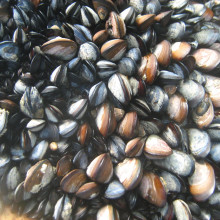
09:33 - Mussels solve sticky problem
Mussels solve sticky problem
with Timothy Lu, Massachusetts Institute of Technology
Mussels are particularly delicious in a seafood paella. But the problem in getting them onto your plate is that you have to first peel them off the rocks and break them open - which can be a challenge. This is because mussels use their powerful foot to cling to surfaces, sticking like glue both in and out of water. Now, researchers have made a biologically-inspired glue, using mussel foot proteins, to create a super-strong substance that could be used in a number of useful ways, from repairing ships to sealing up human surgical wounds. Amelia Perry spoke to Timothy Lu, who led the work...
onto your plate is that you have to first peel them off the rocks and break them open - which can be a challenge. This is because mussels use their powerful foot to cling to surfaces, sticking like glue both in and out of water. Now, researchers have made a biologically-inspired glue, using mussel foot proteins, to create a super-strong substance that could be used in a number of useful ways, from repairing ships to sealing up human surgical wounds. Amelia Perry spoke to Timothy Lu, who led the work...
Timothy - Well, mussels have this really impressive ability to stick to surfaces underwater, and so we've been inspired to do is to use the tools of synthetic biology to see if we can take those proteins and try to put them into an artificial system to make them better. So, what we did was to actually combine the adhesive properties of mussels with the adhesive properties of bacteria. What we've done is to fuse those mussel foot protein genes with genes in E. coli that encode the production of what's known as curli fibres. Curli fibres are these extracellular fibres that bacteria make and they're self-assembling fibres, and so, what we've done now is to make these curli fibers fuse with the mussel foot proteins such that we have a big jumble of these fibres on the outside of the bacteria that display these mussel foot proteins, thus allowing us to get very strong adhesion to surfaces.
Amelia - So you inserted genes from the mussels, put them into E. coli, and essentially used them as mini bacterial factories in order to produce this glue. How did you go about extracting it?
Timothy - That's right. So, we took the DNA from the mussels, we can combine it with the DNA that encodes the curli fibres from E. coli and then we insert that hybrid set genes into bacteria and have them be factories to make a lot of these sticky, curli proteins. Now, the interesting thing is when you do this, the bacteria essentially make tons and tons of these fibres and what you can do is extract fibres from the bacteria, either by cracking the cells open and pulling out those proteins, and then what we do is purify those proteins, and then assemble the fibres in a test tube.
Amelia - Are you producing enough of this glue for an industrial scale here, or is this still very small steps at the moment?
Timothy - We've primarily focused on small-scale production because we wanted to first verify that the materials have the desired properties. That being said, because we are making these glues in bacteria and there are a lot of well validated industrial processes for making proteins out of bacteria - we believe we can scale this up into much larger settings to make practical scale materials. There are a lot of potential applications. One obviously, is to use the glues for underwater repair of ships and other underwater materials. Another possible application is actually use this glue in patients where you often want to adhere different pieces of tissue together in wet conditions in the body during surgery or other medical operations. Finding good underwater glues that can stick surfaces together and maintain that adhesive nature is a challenge so we think that with further development, these types of glues may also be useful for human applications.
Kat - Timothy Lu at the Massachusetts Institute of Technology and they published that work this week in Nature Nanotechnology.

12:50 - Breakthroughs in antibiotic resistance
Breakthroughs in antibiotic resistance
with David Walker, UK Deputy Chief Medical Officer, Michael McArthur, Procarta Biosystems, Ewan Harrison, University of Cambridge, Vanya Gant, UCL
According to the government's chief medical officer, Dame Sally Davies, the danger posed by bacteria becoming resistant to antibiotics should be ranked along  with terrorism on a list of threats to the nation. We need to tackle this problem head-on by creating new antibiotic drugs, by using the ones we got more carefully, and developing new strategies to stop superbugs taking hold in the first place. This was the message at a conference in Cambridge entitled "one bug one drug".
with terrorism on a list of threats to the nation. We need to tackle this problem head-on by creating new antibiotic drugs, by using the ones we got more carefully, and developing new strategies to stop superbugs taking hold in the first place. This was the message at a conference in Cambridge entitled "one bug one drug".
Representatives of pharmaceutical companies and drug discovery ventures got together to develop a plan of action. Chris Smith went along to meet some of them to hear about the approaches they're taking. Dame Sally Davies wasn't there this time, but her deputy, David Walker, was...
David - We're facing a very important problem here. Progressively, bacteria are becoming resistant to antibiotics. Over the last 20 years, we've seen a decline in the production of new antibiotics and so we face a problem in that we are having fewer and fewer antibiotics to treat more and more infections.
Chris - And if we take this to its logical conclusion, what's the end of the story?
David - Well, if we're not able to produce a steady supply of new antibiotic products, then more and more infections are going to become more difficult to treat and some of the more conventional procedures we use in medicine are going to become much more risky. Things like transplantation, joint replacements, and of course, the treatment of classical infections will become very difficult.
Chris - Is there any evidence that this is actually happening?
David - Yes. Well, we are seeing increasing numbers of infections by resistant organisms and these not only have worse outcomes, they're also much more expensive to treat.
Chris - Let's talk to a group of people who are actually working on pioneering the next generation of treatments to address the issues that David's raised.
Michael - I'm Michael McArthur, Procarta Biosystems. What we're trying to develop is a new class of antibacterials. We do this by taking small fragments of the bacteria's own DNA and these bind to key proteins called transcription factors that control gene expression. Without that ability, they're unable to cause disease and they rapidly die.
Chris - So in a normal bacterial cell, they will make these chemicals called transcription factors which go on to their DNA and turn genes on and off that the bacteria needs to control. You're saying if you put in bits of the bacterial DNA artificially, they could, what, soak up all these transcription factors so they don't go where they're supposed to and this is going to disrupt the ability of the bacteria to control themselves.
Michael - That's right. It's a very simple approach.
Chris - This means then that because you know what the genetic sequence of the bug you want to treat is, you could make little pieces of DNA, which means that they will exclusively target that microorganism, which would leave the good bacteria in the body untouched.
Michael - That's right, yes. We can develop bespoke antibacterials with a very narrow and defined spectrum.
Chris - Where are you with this? Is it ready to go?
Michael - So, we're in the process of taking things into animal models. So that puts us about four or five years out from what we'd hope would be successful clinical trials.
Ewan - My name is Ewan Harrison and I'm a researcher in the Department of Veterinary Medicine in the University of Cambridge. We're working on MRSA, which is Methicillin- resistant Staphylococcus aureus. One form is a hospital super bug that's caused massive problems. We're also interested in this because there are some kinds of MRSA that now are starting to become a problem, particularly in continental Europe, and we think this is coming from animal populations, in particular, pigs. We're working using genomics, so this is sequencing the DNA of the bacteria to look at how the bacteria is moving from animal populations into people, and so to do this, we construct a family tree of bacteria and we look for the direction that we think that the bacteria are moving.
Vanya - Hello, I'm Vanya Gant. I'm consultant microbiologist at UCLH in London. I'm leading a group to develop some diagnostics whereby you can find those antibiotic-resistant bugs more quickly, but my other interest which I think really, really does need to be followed up relates to probiotics. These are the so-called good bacteria and they live in our bowels and one of the things they do is they keep the bad bacteria out. I have a very strong suspicion that it might be possible to keep the bad bacteria out by feeding people large amounts of probiotics.
Chris - This will outcompete the bad guys but only in the intestines, surely, if one of your patients is already got an infection in their brain or in their chest, you can feed them all the bugs that you like but it's not going to treat their chest infection.
Vanya - Yes, that's true, but in my field of work, I'd say well over three quarters of the life-threatening infections arise from those bugs that live in the intestines and when you haven't got any immunity they then end up in the blood, and the brain, and wherever else they can cause trouble.
Chris - Have you got a strategy that will enable us to do this?
Vanya - Well, yes, I have got a strategy. The big problem with probiotics is that 98% of them, as you buy them over the counter, just do not work.
Chris - Because you eat them. They go into your stomach, the acid kills them and they don't actually ever end up in your intestines to do you any good. So, people are wasting their money effectively, aren't they?
Vanya - That's exactly right. I know of one or possibly only two compounds in liquid form in this country that survive stomach acid and actually do what they say on the tin. We have to do a proper trial whereby half the patients get the probiotics and the other half don't, and we have a look for positive health benefits in terms of controlling antibiotic resistance and possibly even being able to get rid of the bad bugs that have set up home in these patient's intestines.
Chris - UCL's Vanya Gant with what sounds like pretty damning indictments of most probiotics.
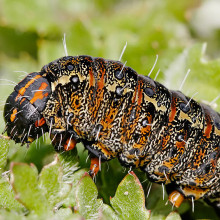
18:31 - Caterpillar camouflage
Caterpillar camouflage
with Hanna Kokko, University of Zurich
Brightly-coloured caterpillars are commonplace in the garden. The colour acts as a warning to birds that they taste unpleasant and shouldn't be eaten. But other caterpillars - which you probably haven't noticed - prefer to go undercover, camouflaging themselves cryptically to blend-in with the garden greenery. But why would different species use such different tactics to avoid becoming a blackbird's lunch? That's a mystery that Hanna Kokko has been trying to solve and she told Kat Arney about how she used some Plasticine and a bike to do so...
Hanna - One thing that a caterpillar needs to do is to grow but the other very important thing it needs to do is to avoid being eaten, and some caterpillars seem to do this by trying to hide as well as they can. So, they have cryptic coloration, it's really hard to find them in vegetation, but others seem to do exactly the opposite. They look extremely brightly coloured, they have stripes, they have hairs, all kinds of things, and these are basically signals that if you're going to eat me, something nasty will happen, so they are often toxic. But the question is, why do we have both strategies in use in nature and what determines who does what?
Kat - How do you figure out what's going on?
Hanna - The method was actually really clever here. So, we had this PhD student with a bicycle and she was going around the entire area and placing tiny little artificial larvae that everybody had created out of Plasticine, and these could be either cryptically colored, so, hard to find, or they could have this sort of very bright orange spots. And she placed them in vegetation, and the nice thing about Plasticine is that if you're a bird that tries to attack this larvae, you can see that later, because of course the bird can't eat it but there's these beak marks that are left there later. So we can come back to the same places again, five days later and then see which larvae have, so to speak, died.
Kat - I don't think I've ever heard of a scientific experiment involving a bicycle and Plasticine before, that's a great idea.
Hanna - It was me who came up with that, but it's great.
Kat - So, what did you find? I mean, which were the kind of the little brown and green larvae, did they get eaten, or the brightly colored ones?
Hanna - There was a really clear change. Actually, two changes over the season. So, very early in the season when there's only adult birds around, they are still incubating, there's no fledglings - the bright coloration was actually a protection. In the middle of the season, it was very different patterns, it was actually better to be cryptic and then late in the season, it switched again. So, the interpretation is that in the middle of the season, we have these young birds, they have no idea about life, they just go for whatever's easy to find, so that's when the brightly colored caterpillars get attacked, they get eaten. The birds are learning but in the process, they are killing their prey. Later in the season, they have actually learned that, "Ooh, this brightly colored thing might actually be very distasteful, so therefore, I better avoid it." So, late in the season, it's again better to have these warning colors from the caterpillar perspective. We looked in addition to this artificial experiment, we looked at almost 700 species, all the relevant species of caterpillars that actually occur in Finland where this study was conducted and it looked like they did have different strategies depending on when in the season they are growing. If it was a very early occurring species, so that the larvae are eating their things in early June and so on, then they were bright. In the middle of the season, they were trying to hide as well as they could and the late occurring species, they were, again, really bright which is kind of cool because it totally matches the survival pattern that we get in the Plasticine experiment.
Kat - This is a lovely example, I guess, of the insect population almost working in tandem with the bird population. Do you think this is going to happen for other systems if you look at that?
Hanna - Of course they have totally different goals. I mean, the birds want to find food and the caterpillars want exactly the opposite. They don't want the birds to find food. But I could imagine that this sort of species, our species communities in general, there can be interactions between species that you wouldn't initially think about because essentially, what's happening here is that the late occurring caterpillars, they are kind of exploiting the, you could call it the education effort of the earlier occurring species that are teaching their predators year after year again, that these are the colors you should be avoiding.
Kat - Hanna Kokko from the University of Zurich.
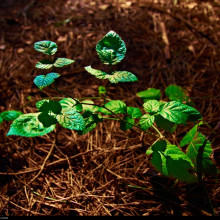
23:04 - What is life and where did it come from?
What is life and where did it come from?
with Nick Lane, UCL
This week, we're looking for life beyond Earth: is there anybody out there? Remarkably,  we're making progress in answering that question. In the last few years, we've discovered that our galaxy is teeming with alien planets but the big question remains - do any of them harbour life? Coming up, how do we define life and how did it begin; what can we tell about planets thousands of light years away and how many alien civilisations they might be home to? Now to many people, astrobiology means the hunt for alien life, but a big part of this is understanding what life actually is, and what's needed for it to exist.
we're making progress in answering that question. In the last few years, we've discovered that our galaxy is teeming with alien planets but the big question remains - do any of them harbour life? Coming up, how do we define life and how did it begin; what can we tell about planets thousands of light years away and how many alien civilisations they might be home to? Now to many people, astrobiology means the hunt for alien life, but a big part of this is understanding what life actually is, and what's needed for it to exist.
Everywhere we look on earth, there's life in an endless variety of shapes and sizes- from microbes to elephants. But how do we define it? What is life and how is it different from non-life? Nick Lane is a biochemist and he spoke to Chris Smith about the origins of life.
Chris - So, how do we tell what's alive like a mouse from a brick? Because chemically they're both made of very similar things.
Nick - It is notoriously difficult to do and actually, I think it's almost pointless to try to define life. I mean, there's hundreds of definitions of life out there and they're all wrong in one way or another. And the problem is that life is really a continuum from a non-living state to a living state and there's all kinds of intermediate stages. So, is a virus alive or not is a question which is often discussed. It's really what life does rather than what it is, and in all these cases, life is making copies of itself and it's using the environment to do so. So, one of the problems with most attempts to define life is that it excludes the environment. All life parasitizes the environment in one way or another. Plants do, they require sunlight, they require carbon dioxide, they require water, and so on, that's all they require. We parasitize the environment a lot more. We go around eating plants and so on. But essentially, all life is parasitizing an environment which is providing it with its energy needs to make copies of itself, so I think you'd say there are about six different things a cell requires. It requires a carbon source to make more copies of itself, it requires energy to bind things together, to make polymers and to produce more cells, it requires excretion, you've got to get rid of the waste products and the end products to drive reactions in a forward direction. There has to be some form of compartmentalization, a cell-like structure that makes the insides different from the outside. There have to be catalysts, the beginnings of biochemical reactions, and then, there has to be some form of replication. Now I think those are the six properties of life that we really need to look for.
Chris - You said that there has to be a carbon source. To what extent is the life we see here on Earth so unique to this environment that you're not going to find it anywhere else or do you think if another planet Earth-like environment exists out there that life would take exactly the same pathway of evolution that it has here and we will be looking at our mirror image out there, somewhere.
Nick - I think that's actually a good argument to say that life could end up, at least at the bacterial level, remarkably similar. I mean, there's a strong argument to say that carbon is really better than anything else. It's much better than silicon, for example, at forming, you know, complex bonds between molecules and it's also available. You know, carbon is far more available in the universe than silicon and also there are gaseous carbon oxides, carbon dioxides, and so on. It's like a Lego brick, whereas silicon oxides are, you know, sands and so on, you can't really boot-strap yourself up from the ground with sand. You can't build on sand.
Chris - So, you're sort of saying that because the rules of physics and chemistry are universal throughout the universe, therefore, exactly the same constraints will exist wherever you live - Milky way or even the Andromeda galaxy and therefore, you're gonna' end up following the same sorts of pathways.
Nick - I think, yes, it's possible. We can conceive that life could've operated in different ways but if you think about the probability of finding life, carbon, water, the kind of rocks that are required for hydrothermal systems and so on. They are all very common, so the kind of life that we have here is likely to be the kind of life that we find elsewhere as well.
Chris - The Earth's four and a half billion years old, so how long after the Earth formed, did life first pop up?
Nick - Well, we don't really know. There's a lot of arguments about it, a kind of glib answer would be about four billion years ago. There are fractionated isotopes of carbon and so on in ancient rock from about 3.9 billion years ago. There's a lot of debate about whether that signifies life or not, but I think most people think on balance, it probably does.
Chris - Where do you think that life came from? What sorts of theories are out there to explain how life arose? Did it arrive de novo, in other words, from scratch here or is it possible that it could have had some kind of injection of some processes from, say, outer space.
Nick - Well, we know for sure that there've been plenty of organic molecules delivered from space on meteorites, there's no question about that. Whether that prompted life on Earth in some way, conceptually what it does really is stock a soup, and so conceptually, it's not really any different to say the Miller-Urey experiment from 50-60 years ago, showing that lightning and UV radiation and so on, can also produce organic molecules, so can hydrothermal vent systems. It's actually remarkably easy in some ways to produce organic molecules and remarkably difficult to get beyond a soup.
Chris - So, would you be in favor then of the idea that life just spontaneously started, or do think that actually that there is credence to this idea that there could have been life coming from elsewhere, maybe intact life coming from elsewhere in the universe.
Nick - There's no evidence to suggest that it did, and actually I think it's a pointless theory in the sense that if it did come from somewhere else, well we still don't know any more about how life started elsewhere. I think we'll never know exactly how life started on Earth but what we can know, what are the principles that lead to the origin of life from a non-living environment, and that's what we're looking for in trying to understand the origin of life here. And panspermia, the delivery of life from space, it just moves the problem somewhere else so it's pointless.

29:43 - The hunt for microbial Martians
The hunt for microbial Martians
with Lewis Dartnell, UCL
Mars is getting crowded: a new NASA vessel slipped into the red planet's orbit last week followed closely by India's satellite sending back its first pictures of the Martian surface. Meanwhile, a number of other countries - Russia, China, Japan - have all announced space programmes to explore the planet in future.
getting crowded: a new NASA vessel slipped into the red planet's orbit last week followed closely by India's satellite sending back its first pictures of the Martian surface. Meanwhile, a number of other countries - Russia, China, Japan - have all announced space programmes to explore the planet in future.
But why? Well, in recent years, there has been a shift from looking for microbial Martians to searching for evidence that Mars was once habitable. And, if it was, might there be fossilised evidence of organisms? Speaking with Kat Arney, Lewis Dartnell is an astrobiologist who specialises in looking for life elsewhere in the Solar System...
Kat - We're stepping away from Earth now to look at our closest planetary neighbor, and it turns out Mars is getting a bit crowded. A new NASA vessel slipped into the red planet's orbit last week followed by India's satellite, sending back its first pictures of the Martian surface while a number of other countries, Russia, China, and Japan have all announced space programs to explore the red planet, but why? Well, rather than looking for little green men actually, they're searching for evidence that Mars was once habitable and if so, whether there might be any fossilized evidence of organisms there. We're joined by Dr. Lewis Dartnell, he's an astrobiologist specializing this. Hi, Lewis!
Lewis - Hello.
Kat - What makes Mars a potential climate for life and what sort of life might we be looking at?
Lewis - Well in many ways, at least early Mars, a kind of primordial Mars, was very much like the early Earth. We think it would have been a warmer, wetter world than we find it today and with the rovers that you have just been mentioning, we found extensive evidence for kind of rivers, and babbling brooks. Curiosity touched, last year, what was last essentially river mud on the bottom of one of these babbling brooks and has looked into the kind of chemistry of the minerals we find there and realize that the water wouldn't have been too acidic, or too alkaline, or too salty, it would've been very clement, very habitable environment for life. So, what you could've done, you could've travelled in a time machine, four billion years into the Martian past, stooped down on the banks of that babbling brook and dunked in a glass, and drunk that Martian river water. It would've been the perfect environment for life to have got started in and to be sustained in.
Kat - We're talking just about bacteria here?
Lewis - Yeah. So we're not talking about little green men, perhaps little green cells, perhaps there's things like cyanobacteria which photosynthesized on Earth and would have been pumping out oxygen-rich atmosphere, maybe there's something as complex as cyanobacteria on Mars but we're not hoping for multicellular life, and certainly not kind of bug eyed aliens.
Kat - Let's certainly hope not. We've learned a lot from the curiosity rover but in terms of finding this clay, is there any chance that we can actually understand if there were bacteria in them.
Lewis - Yes, so. So far, we've been trying to characterize what the Martian environment would be like, whether it was habitable. And what we really want to do next is to see if life did get started there. If you can find so called, biosignatures or signs of life, and what I'm directly involved in at University of Lester is the next ESA, the European Space Agency mission called ExoMars and this will have life detection equipment onboard. It's got something called a Raman Spectrometer which can tell not just the kind of minerals you're looking at but if there are organic molecules, other signs of life. So this is a really exciting mission to be working on.
Kat - And when you think about life on another planet, you think about life on our own planet, it's all based on DNA and this kind of thing, and is there reason to believe that life on other planets would be based on that kind of nucleic acid?
Lewis - As Nick was saying about earlier, Carbon is just really good at doing chemistry, and so for looking for life on other planets, moons, we're gonna' be looking for organic chemistry, organic life because, simply, we know it works. "Hi. Here we are." So, it makes more sense to look for the kind of life that, a) you know works, and b) you would have a good shot at detecting chemical signs of it, but also you don't want to be too specific. You want to kind of keep quite an open mind and perhaps not look for things like DNA itself but signs of complex organic chemistry in general. So there's always that kind of dramatic tension between trying to be broad-minded, you can find stuff that's, by definition, different to you, alien but also have a good chance of finding it.
Kat - And I guess if you did find DNA, that might tell you that perhaps there is credence to this sort of DNA or organisms floating about in space and hopping off on different planets.
Lewis - Well, actually DNA isn't particularly stable in a rock over long periods of time. And we've been looking for things like amino acids and what actually might be the very best outcome for life on Mars. If you find organic molecules and find amino acids and realize that those amino acids are the same handedness as life on Earth, i.e. that they have selected the same mirror image version amino acids that would've been a very intriguing outcome. But also, might be quite frustrating because we'll find it difficult to be able to tell if you'd find Martian life. Something that had its own independent genesis on Mars, or maybe found terrestrial life that contaminated Mars, either billions of years ago inside a meteorite, or perhaps more recently with one of, you know, our own dirty probes, perhaps we're going to find your own dirty fingerprints.
Kat - Oh dear!
Lewis - The best possible outcome would be to find amino acids on Mars that have got one particular handedness i.e. it's definitely a product of life but is right-handed, not left-handed because that would tell us that it's Martian life, not Terrestrial life.
Kat - And what you've said implies that we might be looking for life that is long gone and not there anymore. Do you think there's any chance that they could be kind of living life?
Lewis - So the Martian surface today is a really unpleasant place to find yourself in and the whole planet suffered some kind of environmental catastrophe, some kind of climactic decline. So life on the surface has probably been driven extinct and the surface of Mars now is drenched in ultraviolet radiation and radiation from outer space, the cosmic rays that I study but you only have to go a couple of meters underground to get protection from that. But if we're looking for life that is like living and active today, you'd probably have to go several kilometers underground where the, you know, the warm innards of the planet's enough to thaw out that ice into liquid water which active life needs. So perhaps decades and decades down the line, we might start envisioning almost kind of an industrial action on Mars to drill very deep into the crust and find if there's an active biosphere down there.
Kat - So, future generations of scientists, when we land there, they'll be like digging down, looking for the alien civilization.
Lewis - For that, you'd probably have to have humans on Mars rather than just robots which we're sending at the moment.
Kat - But I mean though, are you optimistic that we will find life there? Where do sit on the scale?
Lewis - I kind of bet my career on it. I'm pursuing a career in astrobiology and I think there's a good enough chance to find something in my career, in my lifetime that it is worthwhile to kind of be spending time. I just find it absolutely fascinating as well. There are few areas of science which I think are so potentially profound if we get the answer we're looking for.
Kat - And do you find yourself staring up at the night sky, just looking up at it
Lewis - Wondering if anything is waving back.
Kat - Waving. Do you wave?
Lewis - No, do you wave, Kat. There's a little window into your psyche.
Kat - Just in case. Anyway, we'll be coming back to both Lewis and Nick Lane later, that's alien hunter Dr. Lewis Dartnell and his quest to find microbial Martians.

35:52 - Looking for life light years away
Looking for life light years away
with Eleanor Bacchus, University of Cambridge
How can we tell if a distant planet is potentially habitable when it's light years away across the Milky Way?  One way is by looking in the Goldilocks zone - this is the planetary zone around a star where it's not too hot or too cold - and measuring how the spectrum - or colour - of light from the star changes when it passes through the atmospheres of any planets. This can tell you what's in those atmospheres, as Cambridge astrophysicist Eleanor Bacchus explained to Chris Smith.
One way is by looking in the Goldilocks zone - this is the planetary zone around a star where it's not too hot or too cold - and measuring how the spectrum - or colour - of light from the star changes when it passes through the atmospheres of any planets. This can tell you what's in those atmospheres, as Cambridge astrophysicist Eleanor Bacchus explained to Chris Smith.
Eleanor - So certain molecules you have, or certain elements, they absorb and re-emit different colors of wavelengths, so if you imagine looking at a white light source and you split this light up into different colors like you would if you're seeing a rainbow. We're looking for colors that are missing or colors that are more intense than we might otherwise expect them to be and that will give us an indication of what sort of elements or compounds are in the atmospheres of these planets.
Chris - I mentioned the light coming through the atmosphere. Do we only look in that way or could we look at the reflected light from an orbiting planet and do the same thing?
Eleanor - Yes. So that's a lot more difficult but what you basically have here are two different methods of looking at a spectrum of a planet. The one where you have the light coming through the atmosphere is known as transiting, so you're looking at the planet as it passes in front of the star, and then the other method that was mentioned is actually what I work on which is called direct imaging and we're looking for the light that's coming specifically from the planet and this light, in the cases where the planet's habitable, will be light reflected off the exoplanet's atmosphere that's actually coming from the star.
Chris - How far away are the objects you're studying?
Eleanor - So the nearest star is maybe about four light years away and we do think there's a planet around there but we can't, sort of maybe... ten light years at most at the moment. So, it's really very, very close by in terms of the size of the galaxy, let alone the size of the universe.
Chris - How do you do these experiments? Because I would think that the light that's coming from the star is tremendously bright, compared with anything that's reflected off a little planet next door, so how do you get away the light from the star compared with the planet itself?
Eleanor - With an awful lot of difficulty really.
Chris - You're shaking your head.
Eleanor - Yeah, it's incredibly hard. So, it's this very, very, very complicated instrumentation involved which to be honest it took me about a year to get my own head around. But fundamentally we can focus the light from the star into a specific region on telescope instead of channel it away, and then hopefully, after an awful lot of post-processing, and complicated computer algorithms, get like a couple of pixels which is a tiny blob and you point at that, and you go, "That's probably a planet, maybe, we hope."
Chris - So there's a little way to go at the moment you're sort of saying.
Eleanor - Yes.
Chris - But if I were to look at a planet, how would I tell whether the molecules in the atmosphere are indicating a planet which could be home to life or could provide a hospitable environment from one which wouldn't? What sort of parameters are you looking at?
Eleanor - I mentioned earlier something called bio-signatures and these are really the important things we're looking for and in terms of looking at exoplanets, we're looking for specific gases really in the atmosphere that can only really be created by life. So the common examples that people often use are things like oxygen and methane in our atmosphere where they're sort of metabolic byproducts and we can't produce them in the labs that we see in our atmosphere by any sort of geological or photochemical processes, they have to be produced biologically.
Chris - There was some controversy on Mars though, wasn't there? With these methane seeps. People said, "Oh look! This is perhaps evidence of subsurface microorganisms or something like that." They've largely backed down from that theory, so that still leaves you in the same sort of situation doesn't it? Because all you can see is literally the signature of a chemical, you can't distinguish between, say different heavier or lighter forms which a life scientist could do on Earth to distinguish a life-giving process versus a non-life generating process.
Eleanor - Yeah. It's incredibly difficult, so a lot of work at the moment is going into coming up with what possible biosignatures we might have and to be honest, I don't think we have any at the moment that are definitively, if you saw this you would know there was life there. All of them have a kind of false-positive scenario which we would have to sort of try and rule out by just looking at maybe other elements that we can see in the atmosphere, or trying to find out sort of more fundamental parameters about the planet, so, where it is in the habitable zone.
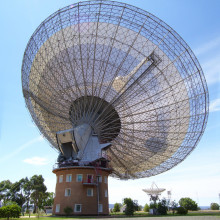
40:34 - Is there anybody out there?
Is there anybody out there?
with Duncan Forgan, University of St Andrews
We can probably detect places in the galaxy that might harbour life, and we might be able to  tell whether it's intelligent or not, but what are the odds that they're there at all?
tell whether it's intelligent or not, but what are the odds that they're there at all?
50 years ago astrobiologist Frank Drake proposed an equation that now bears his name to estimate of the likelihood of discovering intelligent extraterrestrial life in the galaxy. Astrophysicist Duncan Forgan has been using computer modelling together with recent astronomical discoveries, to build upon Frank Drake's work to get a more accurate idea of whether there's anybody out there, as he explained to Graihagh Jackson...
Duncan - Well, the Drake equation is a series of seven or eight terms, depending on who you speak to. These terms get multiplied together and when those terms are multiplied together, you get a number, and that number tells you, if you look up at the night sky, that's how many communicating intelligent species there are.
Graihagh - Okay, so in this Drake equation, you start with how many stars are forming every year in our galaxy and then you subtract out all the stars that don't have any planets around them, right? Because you can't have life there, and then you subtract out all the planets that are too far or too close to the sun to support life, and so on and so on. You get the idea. Until finally, you come up with the number of planets, with intelligent life, that could transmit radio signals and be alive right now. So when you slot all the numbers into this equation, what'd you get?
Duncan - Typically, when I try and write down numbers in this equation I get the total number of intelligent civilizations to come out in quite small numbers, let's say ten civilizations in the milky at this point in time.
Graihagh - Ten. Does that include us or exclude us?
Duncan - Strictly speaking, that includes us, so you should take one off. It should be nine.
Graihagh - Nine? That's even worse!
Duncan - Yes. It's quite a tough challenge. Before we get into this, I should just point out that SETI scientists and astrobiologists don't use Drake's equation as a predictive tool. It's quite clear that it's very simple and kind of cuts out a lot of the nuance and the sophistication required to make an answer to that kind of question.
Graihagh - I'm wondering 50 years on, is there not a better way to make a more informed guess?
Duncan - Other ways you can look at this question would be to say, okay, we have statistical information on how stars form, we can say things in a similar vein about the masses of planets, we can say things about the likelihood of them existing a certain distance from the star, so you can build up a statistical picture of what the Milky Way looks like in terms of its star and planet population. And once you have that, then you can essentially build a model in which you can test different scenarios.
Graihagh - So what predictions have you been able to make?
Duncan - So when I first started doing this, I ran several different scenarios. Some were quite optimistic and some were quite pessimistic. And over the course of the Milky Way's existence, I showed that there would be somewhere between, you know, 300 and 30,000.
Graihagh - Not so many given how many stars and planets there are out there then.
Duncan - That's right. Of course, these are very speculative numbers though, because we're still stuck with the same problem that we just don't know how life forms on other worlds and we don't know really how that life becomes intelligent. So you're still saddled with these uncertainties but you can say given our uncertainties and making some sensible educated guesses, here are some nice sensible looking bounds in which we can put those numbers.
Even when you take a fairly optimistic view of the equation and you put in some quite generous values for some of the terms and if you get a number that's say tens of thousands, which sounds like a much bigger number. The Milky Way is very big, it's very big in space, it's about a hundred thousand light-years across and it is also very big in time, it's billions of years old. So we have this kind of dual quandary of how you get two civilizations to be close to each other in space and close to each other in time to appear about the same time. If one sends a radio signal, the other can see it before the other civilization goes defunct for whatever reason that might be.
Graihagh - And by Duncan's calculations, intelligent life that can transmit radio signals across the galaxy are likely to be alive for just one thousand years. A thousand years in a galaxy that is 13.2 billion years old with 300 billion stars and many, many more planets. When you take all of this into account, it seems pretty improbable that if there is anyone up there that will ever get the chance to talk.
Duncan - The probability might be low but that doesn't mean it's impossible, it just means that it's improbable. So even if we carry out a search knowing that we're likely to fail, actually failing in the search is quite important because again, I'm just a theorist with a computer making some assumptions. At the end of the day, if you want to do it scientifically, you have to go out there and test it. So, you've to make sure that you've got observations to back up your theories and if we made a null detection after a significant and deep search, that has a lot of information in it as well as the opposite case where did detect something. It will still tell us something quite fundamental and important about what it means to be human.
Graihagh - I was gonna' say what would that mean if we were the only sentient beings out there.
Duncan - It means that our existence is quite lonely and quite unique, and that human life in itself is even more precious than we might have thought originally.
Graihagh - And in some senses I guess then that would also mean that intelligent life of the whole galaxy rests on our shoulders.
Duncan - Well, in that sense, the stewardship of the Earth is not the only thing we are stewards of. We become stewards of a much larger volume of the universe and we have to be very careful and look after it if that is the case. So again, that has very strong implications for how we should behave as a civilization.
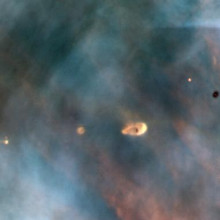
46:28 - Astrobiology: What's the point?
Astrobiology: What's the point?
with Eleanor Bacchus, University of Cambridge, Lewis Dartnell, UCL and Nick Lane, UCL
If it's highly unlikely that we'll ever be able to detect intelligent life, should we  continue on in our efforts to find ET? Would the money, time and effort not be better directed elsewhere? Chris Smith put these questions to Eleanor Bacchus, Lewis Dartnell and Nick Lane, and started by asking Eleanor if there are any spin-off technologies from astrobiology developments...
continue on in our efforts to find ET? Would the money, time and effort not be better directed elsewhere? Chris Smith put these questions to Eleanor Bacchus, Lewis Dartnell and Nick Lane, and started by asking Eleanor if there are any spin-off technologies from astrobiology developments...
Eleanor - There's an awful lot of funding around for exoplanets at the moment because it's a really - well, it's a really trendy subject in astrophysics. There's a lot of grants for it and this is pushing our technology because it's such a difficult problem. It's pushing technology to sort of limits that people couldn't really imagine before and this has just spun off into medical uses as well. So, there are some of our telescope technology is actually used in looking at people's eyes. There's one of these that I came across that I wasn't aware of before which was pretty astounding.
Chris - It's ironic to think of turning the telescope around, isn't it?
Eleanor - Yeah.
Chris - We're taking something very powerful to look at something very miniscule. I think also, someone said to me that if it wasn't for astronomy and astrophysics, we wouldn't have Wi-Fi that we all use on the internet every day and of course the SKA, the Square Kilometer Array, world's most powerful telescope they're building. That's gonna generate as much data in a day as the whole world generates in a year at the moment, so we've got to marshal big data better. Nick Lane, what do you think about this whole business of looking for life out there? Do you think we should be looking for life in Cambridge, or we should be looking for life elsewhere in the universe?
Nick - Yeah. I think, I think it's overwhelmingly likely that life will arise on more or less any wet rocky planet, including Mars. I would agree with Lewis. I would be very disappointed if it hadn't, but complex life like ourselves, I think that's far, far more rare. All complex life on Earth only arose once in 4 billion years and so that's highly improbable for whatever reasons that we're trying to understand. Should we therefore look for complex life out in the rest of the universe? I would say, yes, because we don't understand what the reasons are here. We're trying to get at it but again, observational data is the only that's going to give us any kind of an answer.
Chris - And Lewis Dartnell, thirty seconds. So, SETI? Yes or no?
Lewis - My personal belief is that SETI will not detect anything. There is no other intelligent civilization in our galaxy. However, I think we should still be looking for it because it's an incredibly cheap thing to do but the repercussions would be so incredibly profound if we find an interstellar text message tomorrow.

How many people have ever lived on Earth?
- Previous Common cold and asthma
- Next Do baby fish speak?









Comments
Add a comment